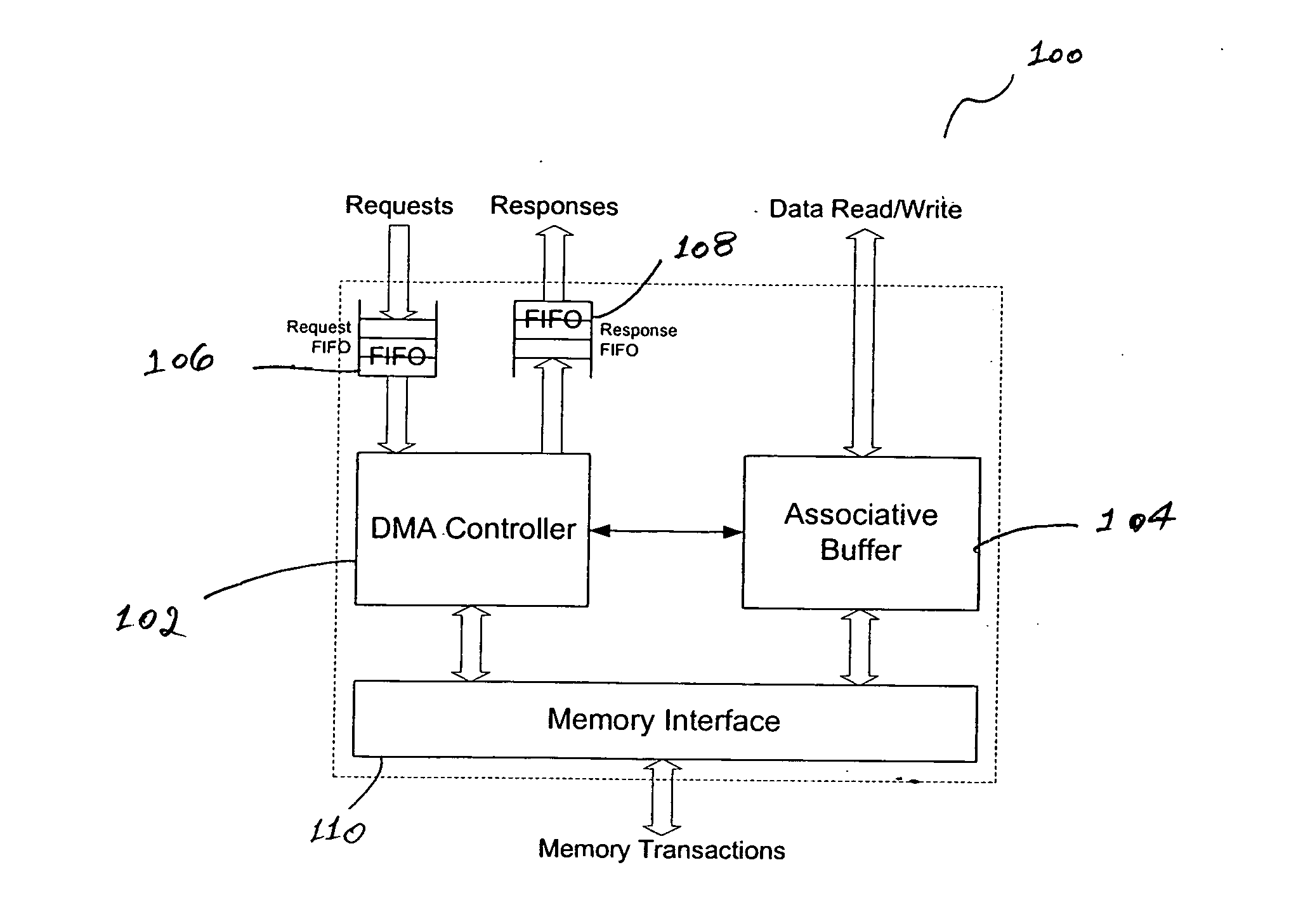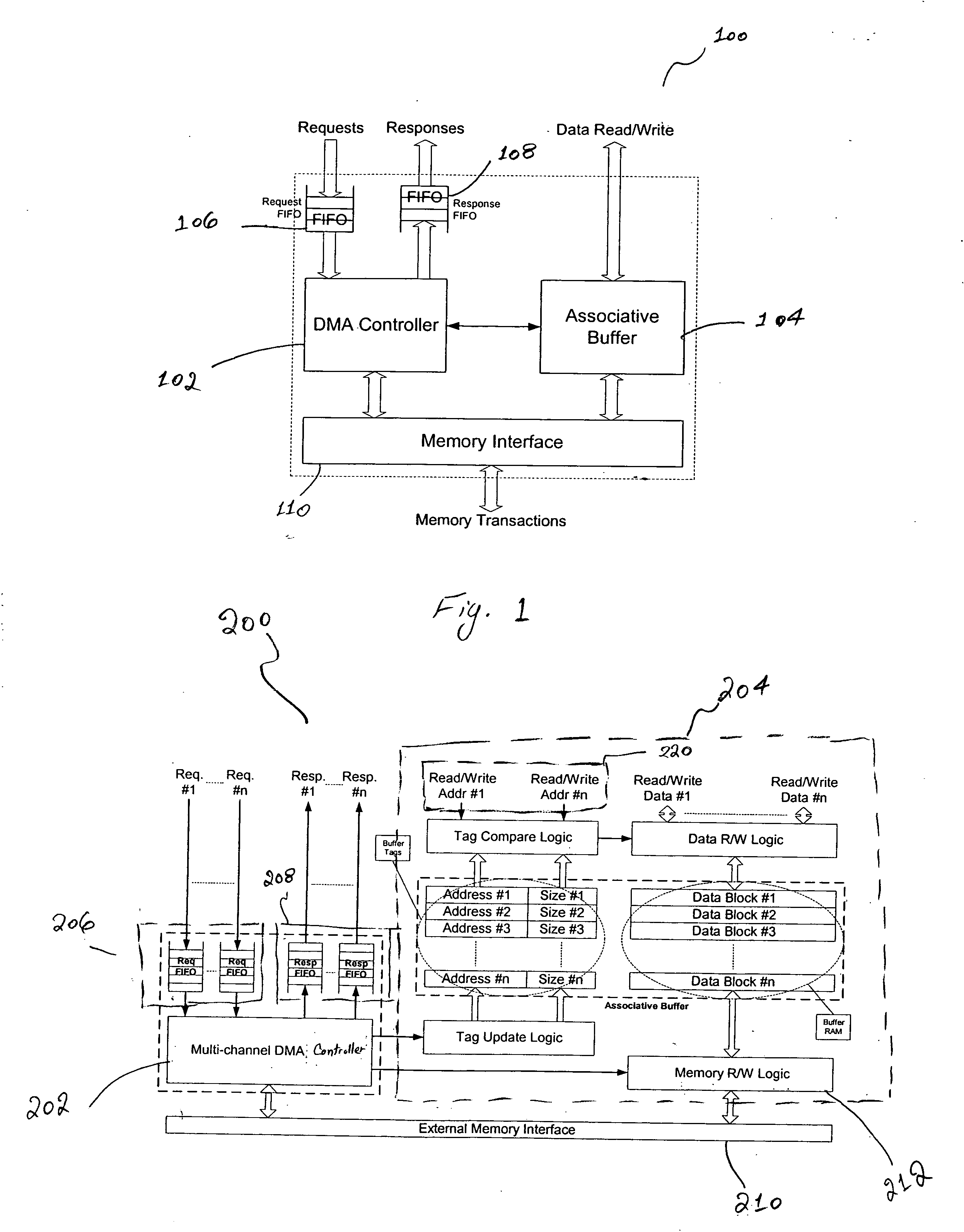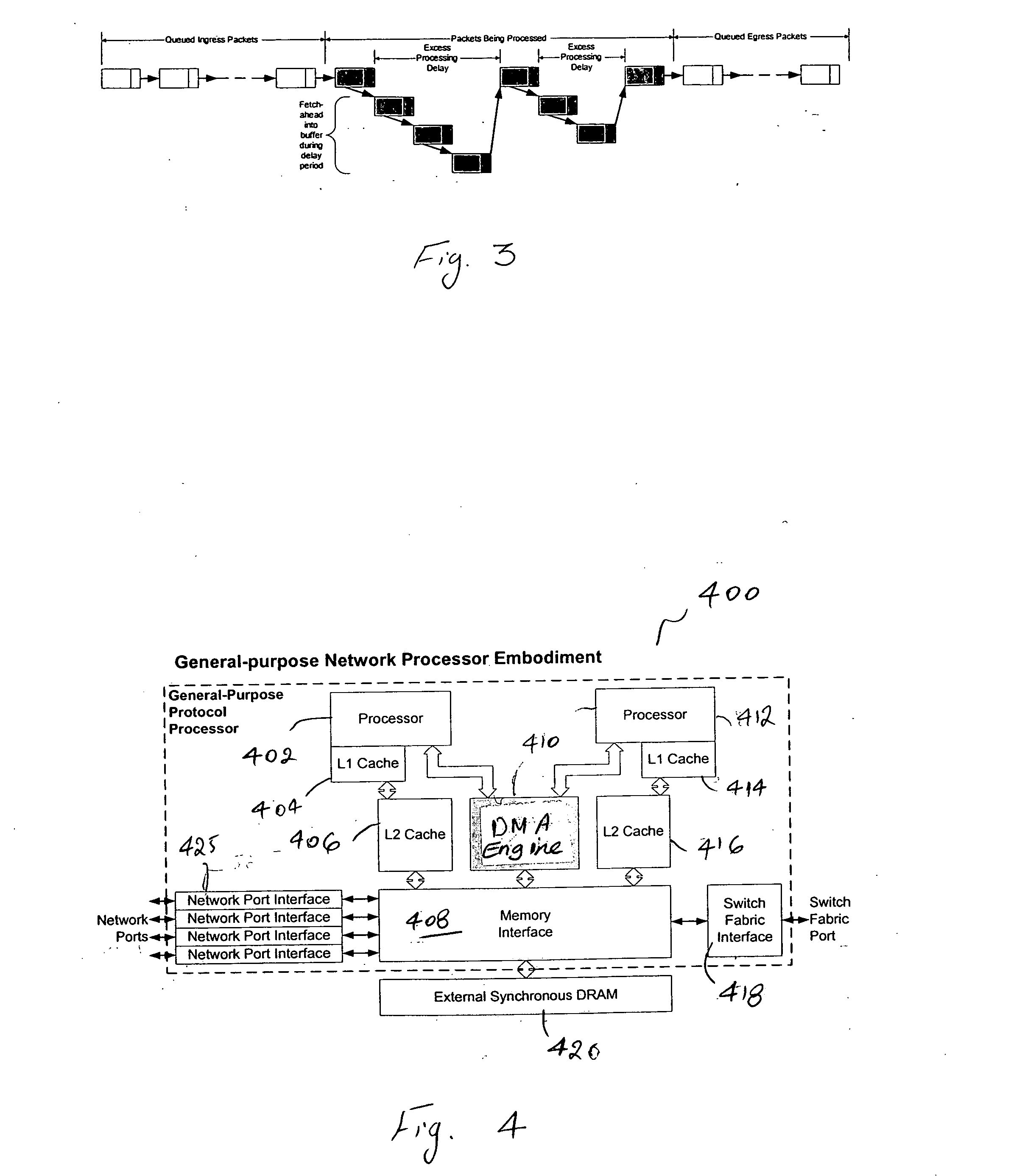Failure to keep up with the fundamental
link rate often means that packets will be dropped or lost, which is usually unacceptable in advanced networking systems.
This is, however, very expensive to implement.
Another known approach is the use of multiple lower-performance CPUs to carry out the required tasks; however, this approach suffers from a large increase in
software complexity in order to properly partition and distribute the tasks among the CPUs, and ensure that
throughput is not lost due to inefficient inter-CPU interactions.
However, these systems have proven to be limited in scope, as the special-purpose hardware assist functions often limit the tasks that can be performed efficiently by the
software, thereby losing the advantages of flexibility and generality.
One significant source of inefficiency while performing
packet processing functions is the latency of the memory subsystem that holds the data to be processed by the CPU.
Note that write latency can usually be hidden using caching or buffering schemes; read latency, however, is more difficult to deal with.
In addition, general-purpose computing workloads are not subject to the catastrophic failures (e.g.,
packet loss) of a hard real
time system, but only suffer from a gradual performance reduction as memory latency increases.
In
packet processing systems, however, little work has been done towards efficiently dealing with memory latency.
The constraints and requirements of
packet processing prevent many of the traditional approaches taken with general-purpose
computing systems, such as caches, from being adopted.
However, the problem is quite severe; in most situations, the latency of a single access is equivalent to tens or even hundreds of instruction cycles of the CPU, and hence packet processing systems can suffer tremendous performance loss if they are unable to reduce the effects of memory latency.
Unfortunately, as already noted, such hardware assist functions greatly limit the range of packet processing problems to which the CPU can be applied while still maintaining the required
throughput.
In this case, the latency of the SDRAM can approach a large multiple of the CPU
clock rate, with the result that direct accesses made to SDRAMs by the CPU will produce significant reductions in efficiency and utilization.
As a 1 Gb / s
Ethernet data link transfers data at a
maximum rate of approximately 1.5 million packets per second, attempting to process
Ethernet data using this CPU and SDRAM combination would result in 75% to 90% of the available processing power being wasted due to the memory latency.
This is clearly a highly undesirable outcome, and some method must be adopted to reduce or eliminate the significant loss of processing power due to the memory access latency.
However, caching is quite unsuitable for
network processing workloads, especially in
protocol processing and packet processing situations, where the characteristics of the data and the memory access patterns are such that caches offer non-deterministic performance, and (for worst-case traffic patterns) may offer no
speedup.
This approach places the burden of deducing and optimizing memory accesses directly on the
programmer, who is required to write software to orchestrate data transfers between the CPU and the memory, as well as to keep track of the data residing at various locations.
These normally offer far higher utilization of the CPU and the
memory bandwidth, but are cumbersome and difficult to program.
Unfortunately, the approaches taken so far have been somewhat ad-hoc and suffer from a lack of generality.
Further, they have proven difficult to extend to processing systems that employ multiple CPUs to
handle packet streams.
This is a crucial issue when dealing with networking applications.
Typical network traffic patterns are self-similar, and consequently produce long bursts of
pathological packet arrival patterns that can be shown to defeat standard caching algorithms.
These patterns will therefore lead to
packet loss if the statistical nature of caches are relied on for performance.
Further, standard caches always pay a penalty on the first fetch to a data item in a cache line, stalling the CPU for the entire memory read latency time.
Networking and packet processing applications also exhibit locality, but this is of a selective and temporal nature and quite dissimilar to that of general-purpose computing workloads.
In particular, the traditional set-associative caches with least recently used replacement disciplines are not optimal for packet processing.
Further, the typical sizes of the data structures required during packet processing (usually
small data structures organized in large arrays, with essentially
random access over the entire array) are not amenable to the access behavior for which caches are optimized.
Software transparency is not always desirable; programmers creating packet processing software can usually predict when data should be fetched or retired.
Standard caches do not offer a means of capturing this knowledge, and thus lose a significant source of deterministic
performance improvement.
Accordingly, caches are not well suited to handling packet processing workloads.
There is a limit to how much this capability can be utilized, however.
If the DMA is made excessively application-specific, then it will result in the same loss of generality as seen in Network Processors with application-specific
hardware acceleration engines.
A typical issue with
alternative methods (such as cache-based approaches) is that additional data are fetched from the main memory but never used.
This is a consequence of the limitations of the architectures employed, which would become too complex if the designer attempted to optimize the fetching of data to reduce unwanted accesses.
However, DMA engines suffer from the following defects, when applied to networking: 1.
Relatively high SW overhead: typical general-purpose DMA controllers require a considerable amount of
programmer effort in order to set up and manage data transfers and ensure that data are available at the right times and right locations for the CPU to process.
In addition, DMA controllers usually interface to the CPU via an interrupt-driven method for efficiency, and this places an additional burden on the
programmer.
These bookkeeping functions have usually been a significant source of software bugs as well as programmer effort.
Not easy to extend to multi-CPU and multi-context situations.
Due to the fact that DMA controllers must be tightly coupled to a CPU in order to
gain the
maximum efficiency, it is not easy to extend the DMA model to cover systems with multiple CPUs.
In particular, the extension of the DMA model to multiple CPUs incurs further programmer burden in the form of resource locking and consistency.
The DMA model becomes rather unwieldy for processing tasks involving the handling of a large number of relatively small structures.
The comparatively high overhead associated with setting up and managing DMA transfers limits their scope to large data blocks, as the overhead of performing DMA transfers on many
small data blocks would be prohibitive.
Unfortunately, packet processing workloads are characterized by the need to access many
small data blocks per packet; for instance, a typical packet processing
scenario might require access to 8-12 different data structures per packet, with an average
data structure size of only about 16 bytes.
This greatly limits the improvement possible by using standard DMA techniques for packet processing.
A particularly onerous problem is caused when a small portion of a
data structure needs to be modified for every packet processed.
The amount of overhead is very large in proportion to the actual work of incrementing the counter.
However,
direct deposit caching techniques suffer from the following disadvantages: 1.
Possibility of
pollution / collisions when the CPU falls behind.
If a simple
programming model is to be maintained, then the
direct deposit technique can unfortunately result in the overwriting of cache memory regions that are presently in use by the CPU, in turn causing extra overhead due to unnecessary re-fetching of overwritten data from the main memory.
This effect is exacerbated when
pathological traffic patterns result in the CPU being temporarily unable to keep up with incoming packet streams, increasing the likelihood that the DMA controller will overwrite some needed area of the cache.
Careful
software design can sometimes mitigate this problem, but greatly increases the complexity of the programmer's task.
Results in non-deterministic performance; as a hardware-managed cache is being filled by the DMA controller, it is not always possible to predict whether a given piece of data will be present in the cache or not.
This is made worse due to the susceptibility to
pathological traffic patterns as noted above.
For instance the address tables used to dispatch packets are typically very large and incapable of being held in the cache.
Limited utility for
multiprocessing; as a DMA controller is autonomously depositing packet data into a cache, it is difficult to set up a
system whereby the incoming
workload is shared equally between multiple CPUs.
Software-controlled prefetch techniques, however, suffer from the following issues: 1.
They become hard to manage as the number of data structures grows; the programmer is often forced to make undesirable tradeoffs between the use of the cache and the use of the prefetch, especially when the amount of data being prefetched is a significant fraction of the (usually limited) cache size.
Further, they are very difficult to extend to systems with multiple CPUs.
It is difficult to completely hide the memory latency without incurring significant software overhead; as the CPU is required to issue the prefetch instructions, and then wait until the prefetch completes before attempting to access the data, there are many situations where the CPU is unavoidably forced to waste at least some portion of the memory latency
delay.
This results in a loss of performance.
Software-controlled prefetch techniques operate in conjunction with a cache, and hence are subject to similar invalidation and
pollution problems.
In particular, extension of the software-controlled prefetch method to support multi-threaded
programming paradigms can yield highly non-deterministic results.
 Login to View More
Login to View More  Login to View More
Login to View More 


